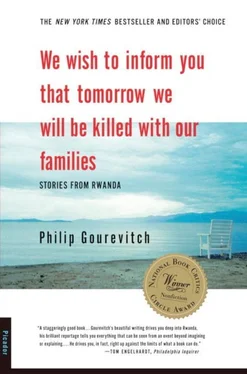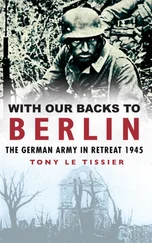From New York, the Secretary-General of the United Nations, Boutros Boutros-Ghali, pronounced that “genocide by starvation” was taking place at Mugunga. Boutros-Ghali had no evidence that anybody was even hungry, and he certainly could not say who was committing this alleged genocide, since refugees could only be hungry because they were being blocked from leaving, and the only people blocking them were other so-called refugees. Still, with reports of famine and mass death among the invisible refugees filling the television news, the Security Council started to draw up plans to deploy a humanitarian, military intervention force to Goma, ostensibly to liberate the refugee masses at Mugunga. This sounded promising, until it emerged that the proposed force might be proscribed by its mandate from doing the one thing that it was needed to do, which was to use force to confront, to disarm, or, if necessary, to overwhelm the Hutu Power army and militias.
AT NINE IN the morning on November 15, 1996, I sat in a house on a hill in Gisenyi overlooking Goma, taking notes from the BBC radio news:
Canadian UN-force commander stresses force will not disarm or separate militants at Mugunga. Late night UN resolution leaves vague how feeding refugees and at the same time encouraging them to return to Rwanda will work. There’s talk of soldiers fanning out from bases in Goma to find and feed refugees. But UN says it won’t reestablish camps. Canadian commander says, “In order to separate militias, the level of violence would be too high and not only soldiers but innocents would be killed.”
I also wrote my impressions of this news:
Another lame UN force. Innocents are getting killed, have been getting killed, and will get killed however this plays out. And how can you feed hundreds of thousands, dig them holes to shit in, give them plastic sheets to sleep under, and say you haven’t established a camp? Anyway, why use an army in a place you don’t care enough to kill and die for? Total paralysis.
Then I switched stations to Radio Star, the rebel “voice of the liberated Congo” from Goma, and took more notes:
The road to Mugunga and west is open. The interahamwe have fled. Announcer says, “The whole problem is cleaned up.” Refugees are marching home to Rwanda. The rebellion continues on to Kinshasa.
This time, my impressions were briefer: “Huh? Can it be?”
I ran out the door, drove to the border and across, into Goma, where I turned onto the Mugunga road, heading west toward the camp, and found myself inching along against a stream of hundreds of thousands of Rwandans heading east, trudging steadily home. Over the preceding days, it turned out, the ADFL and the RPA had again taken the offensive, encircling Mugunga, and attacking it from the rear, in such a way as to draw the armed elements away from the border while pushing the refugee masses homeward. The main evidence of the battle lay nearly twenty miles beyond the camp itself—a line of blown-up trucks, buses, and cars that had been headed toward the Zairean interior. Fluttering around them on the road were heaps of papers, including much of the archive of the ex-FAR high command: receipts for arms shipments from dealers all over Europe, charters for the creation of political front organizations among the refugees, tax collection tables for the camps, accounts of financial transactions with humanitarian agencies, correspondence with Mobutu and his generals—even meticulously handwritten lists of Tutsis in North Kivu.
As the return got under way, it was widely reported that the ex-FAR and the interahamwe had retreated deeper into Zaire with the remnants of Mobutu’s army, allowing the so-called ordinary refugees to head home. The reality was not so perfect: among those who fled west into Zaire’s jungles—perhaps a hundred and fifty thousand people, perhaps twice as many; nobody knows—there were many noncombatants; and inside Rwanda, it quickly became clear that a great number of people with crimes to answer for had melted into the flood of returnees. But the immediate threat to Rwanda of a renewed total war had been removed, and—hap—pily—it appeared that the refugees had not starved in the process.
All along the road to Mugunga and in the rat-infested wreckage of the camp itself, I found aid workers shaking their heads and marveling at the fact that most of the refugees still had at least a few days’ rations and the strength to walk as much as fifteen or twenty miles a day at a brisk clip, carrying impressive loads under a fierce sun. In just four days, some six hundred thousand Rwandans marched back across the border from Goma. By the end of November, the total number of returnees was said to be around seven hundred thousand, and thousands more kept straggling in. Although the Rwandan government continued to issue adamant denials of military involvement in Zaire, General Kagame himself was less guarded. “Because we are not necessarily unhappy about what’s happened—and, on top of that, what has happened is what we would have wished to have happened—I’m sure people would be right to suspect our involvement,” he told me. What’s more, he added, “We have the satisfaction that, on our part, we have always tried to do what we thought was right. There can never be greater satisfaction for me than this. I think it’s a good lesson for some of us. We can achieve a lot by ourselves for ourselves, and we’ve got to keep struggling to do that. If people can help, that’s all well and good. If they can’t, we should not just disappear from the surface of this earth.”
DURING THE DAYS I spent on the road amid the returning six hundred thousand, I was repeatedly visited by an image—remembered or imagined from various paintings and movies—of the Napoleonic armies straggling home from Russia: limping hussars and frozen horses, blood on the snow, the sky a blackness, mad eyes fixed forward. The weather was kinder in Africa, and the people on the road were mostly in good health, but that recurrent image of another time and place made me wonder why we in the West today have so little respect for other people’s wars. The great homeward trundling of these Rwandans marked the rout, at least for the moment, of an immense army dedicated to genocide, yet the world had succored that army for years in the name of humanitarianism.
“To you we were just dots in the mass,” one returnee observed, after I had spent the first days of the migration driving through the boiling swarm on the road from Mugunga. They had always sworn, in the camps, that they would go home as they had left—en masse, as one. To be dots in the mass was precisely the point: it was impossible to know who was who. They came at a rate of twelve thousand an hour (two hundred a minute), a human battering ram aimed at the frontier. But this wasn’t quite the triumphant invasion long promised by the extremist Hutu leaders; rather, it was a retreat from exile conducted in near-silence. At one point, through the men and women and children pouring over fifty miles of blacktop, pushing bicycles, wheelbarrows, motorbikes, even automobiles, dragging wooden crates like sleds, balancing enormous bundles on their heads, toting babies in slings and cradling them in their arms, carrying steamer trunks and empty beer bottles, and sometimes carrying nothing but the burden of their pasts, there came four men shouldering a blanket-draped figure on a stretcher. As they pushed through the knotted thousands, one kept saying, “A cadaver, a cadaver.” What made this man singular was his need to declare himself. Except for the knock of cooking pots, the swish of bare feet and rubber sandals, and the bleat of a stray goat or a lost child, the homecoming throng, as a rule, was ominously mute.
Back in Rwanda, thousands stood for hours along the roads watching the influx with the same wordless intensity. Never before in modern memory had a people who slaughtered another people, or in whose name the slaughter was carried out, been expected to live with the remainder of the people that was slaughtered, completely intermingled, in the same tiny communities, as one cohesive national society.
Читать дальше











